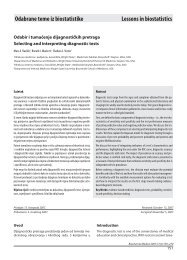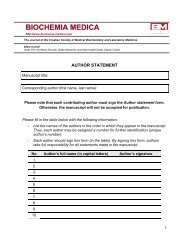Posterske teme Poster topics - Biochemia Medica
Posterske teme Poster topics - Biochemia Medica
Posterske teme Poster topics - Biochemia Medica
You also want an ePaper? Increase the reach of your titles
YUMPU automatically turns print PDFs into web optimized ePapers that Google loves.
P16-6 Molekularna dijagnostika<br />
P16-6<br />
Analitička procjena sustava za umnažanje<br />
DNA u stvarnom vremenu Rotor-Gene 3000<br />
Bobetić-Vranić T, Šiftar Z, Crnković S, Flegar-Meštrić Z<br />
Zavod za kliničku kemiju, KB Merkur, Zagreb, Hrvatska<br />
Rotor-Gene 3000 je otvoreni sustav koji omogućava uporabu<br />
različitih reagensa za umnažanje DNA u stvarnom<br />
vremenu. Programska potpora omogućava analizu podataka<br />
te apsolutnu i relativnu kvantifi kaciju. Cilj studije bio<br />
je analitički procijeniti Rotor-Gene 3000 kvantifi kacijom<br />
fuzijskog transkripta BCR-ABL u bolesnika s kroničnom<br />
mijeloičnom leukemijom u stvarnom vremenu i dobivene<br />
rezultate usporediti s rezultatima reakcije RT-PCR. Analizirano<br />
je 11 uzoraka RNA (cDNA). Devet uzoraka bilo je<br />
pozitivno, a dva su bila negativna na fuzijski transkript<br />
BCR-ABL, što je dokazano pomoću RT-PCR (kvalitativno)<br />
te citogenetski. Za kvantitativno određivanje količine fuzijskog<br />
transkripta BCR-ABL u navedenim uzorcima primijenjen<br />
je LightCycler t(9;22) Quantifi cation kit (Roche<br />
Applied Science). Kit omogućava osjetljivu kvantifi kaciju<br />
i određivanje relativne razine izraženosti transkripata<br />
BCR-ABL u odnosu na razinu izraženosti kontrolnog gena<br />
G6PDH. Količina G6PDH i BCR-ABL (u fg) u pojedinom<br />
uzorku određena je usporedbom vrijednosti Ct (ciklus u<br />
kojem intenzitet fl uorescencije prelazi granicu osjetljivosti)<br />
nepoznatog uzorka sa standardnom krivuljom. Za fuzijski<br />
transkript BCR-ABL raspon količina u uzorcima je bio<br />
od 0,08 fg do 97,64 fg. Za transkript G6PDH raspon količina<br />
u uzorcima je bio od 14,76 fg do 666,25 fg. Normalizirana<br />
vrijednost izraženosti fuzijskog transkripta BCR-ABL<br />
kretala se od 0,00097 do 0,146555. Od 11 testiranih uzoraka<br />
8 ih je bilo pozitivno (s mjerljivom količinom fuzijskog<br />
transkripta BCR-ABL), dok su 3 uzorka ustanovljena<br />
kao negativna (bez mjerljive količine fuzijskog transkripta<br />
BCR-ABL). Rezultati analitičke procjene dokazali su prisutnost<br />
mjerljive količine fuzijskog transkripta BCR-ABL u 8<br />
od 9 pozitivnih uzoraka (osjetljivost 89,9%). Mogući uzrok<br />
snižene osjetljivosti možda je u tome što su uvjeti za reakciju<br />
PCR iz izvornog protokola prilgođeni instrumentu LightCycler<br />
koji rabi staklene kapilare, dok Rotor-Gene ima<br />
plastične tubice. S obzirom na različit toplinski kapacitet<br />
stakla i plastike optimiranje vremena pojedinih koraka<br />
PCR vjerojatno bi dovelo do povećanja osjetljivosti, što<br />
zahtijeva daljnje ispitivanje u okviru proširene analitičke<br />
validacije.<br />
E-mail: tanja.vranic@post.htnet.hr<br />
P16-6<br />
Molecular diagnostics<br />
Analytical evaluation of the Rotor-Gene<br />
3000 real-time instrument<br />
Bobetić-Vranić T, Šiftar Z, Crnković S, Flegar-Meštrić Z<br />
Department of Clinical Chemistry, Merkur University Hospital, Zagreb,<br />
Croatia<br />
The Rotor-Gene real time DNA amplifi cation system is an<br />
open chemistry platform, allowing for the use of any real<br />
time chemistry. The software therefore aims to provide<br />
support to the analysis of data obtained, and absolute<br />
and relative quantifi cation. The aim of the study was to<br />
perform analytical evaluation of the RotorGene 3000 by<br />
quantifi cation of BCR-ABL fusion trancripts in patients<br />
with chronic myeloid leukemia in real time and to compare<br />
the results obtained with the results of RT-PCR<br />
reactions. Eleven samples of RNA (cDNA) were analyzed.<br />
Nine samples were positive and two samples were negative<br />
for BCR-ABL fusion transcript, which was proven by<br />
RT-PCR (qualitative) and cytogenetic studies. The Light-<br />
Cycler t(9;22) Quantifi cation Kit (Roche Applied Science)<br />
was used. The kit enables sensitive quantifi cation and<br />
determination of the relative level of BCR-ABL fusion transcript<br />
expression normalized with G6PDH housekeeping<br />
gene expression. The amount of G6PDH and BCR-ABL (in<br />
fg) in each sample was determined by comparison of Ct<br />
values (number of the cycle when the signal was above<br />
the threshold) of an unknown sample with the standard<br />
curve. The amount in the study samples ranged from<br />
0.08 fg to 97.64 fg for BCR-ABL fusion transcript, and from<br />
14.76 fg to 666.25 fg for G6PDH control gene. Normalized<br />
values of BCR-ABL fusion transcripts expression were<br />
from 0.00097 to 0.146444. From eleven samples tested,<br />
eight were positive (with a measurable amount of BCR-<br />
ABL fusion transcript) and three were negative (without a<br />
measurable amount of BCR-ABL fusion transcript). Results<br />
of the analytical evaluation showed the presence of a<br />
measurable amount of BCR-ABL fusion transcript in eight<br />
of nine positive samples (sensitivity 89.9%). The possible<br />
cause of this lower sensitivity might lie in the specifi c<br />
conditions of reagent kit for PCR reaction, which were<br />
adapted for the LightCycler instrument. It has glass capillaries,<br />
whereas RotorGene has plastic tubes. Considering<br />
the diff erent thermal capacity of glass and plastic, the<br />
optimization of some PCR steps would probably increase<br />
the sensitivity, which calls for additional studies as part of<br />
extended analytical validation.<br />
E-mail: tanja.vranic@post.htnet.hr<br />
<strong>Biochemia</strong> <strong>Medica</strong> 2006;16(Suppl 1):S1–S268<br />
S177






